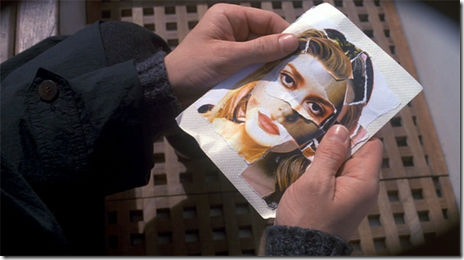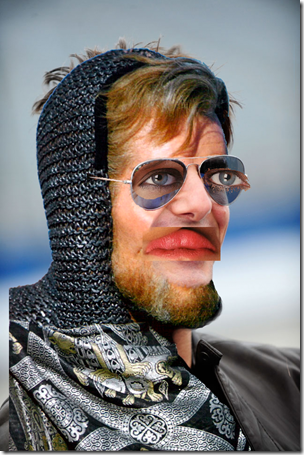Last Wednesday in “Three Reasons Vendors Get It Wrong” I gave three reasons why unwise product managers produce genealogically unsound products: 1. personnel turnover, 2. the deceptive complexity of genealogy, and 3. a chasm that separates time frames 2 and 3.
I was a bit vague about that last one. (Maybe I ran out of time and couldn’t finish the article… Or maybe I wanted to pique your curiosity… Yeah… that’s it… That’s my story and I’m sticking with it.)
There are three time frames or stages of ancestral research. Think of them in this fashion:
1. When we start, we fill our pedigree with people we know. It is easy.
2. We extend our pedigrees with people we know only through vital records. Vital records provide a complete picture of an ancestor. Genealogy is still mostly easy.
3. As we push further back, things take a distinct turn for the worst. Research becomes like something from the Truman Show movie.

Truman doesn't have a photograph of the mysterious Sylvia, so he clandestinely tears scraps from magazine advertisements to recreate her likeness. One ad provides eyes, another her mouth. Gradually he builds a complete picture.
That's a bit like what we must do as genealogists once we push beyond vital records.
Each genealogical record is like a photograph fragment that contributes to the picture. The careful researcher must find fragments that overlap—names, dates, places, and relationships in common—lest we merge photo fragments from the wrong person. Fragments must also add to the picture. It is a painstaking process. Worse, unlike Truman we don’t know beforehand what an ancestor may look like.
 The careless researcher merges photo fragments with the barest of overlap, sometimes amalgamating fragments from multiple people into a picture that bears no resemblance to an actual person.
The careless researcher merges photo fragments with the barest of overlap, sometimes amalgamating fragments from multiple people into a picture that bears no resemblance to an actual person.
Let me illustrate. Observe the reconstructed photograph to the right. I've put together parts from three different celebrities. The result is hideous indeed. (Can you guess who the three celebrities are? I'll give the answer tomorrow.)
Genealogy in the third stage is distinctly different. Before, genealogy was simple. Genealogists searched for people or for nearly complete photographs of people—vital records that served as people surrogates.
Now, genealogy is tough. Genealogists search for records, not people. The people we reconstruct may or may not look like the individuals they are meant to be. If we carelessly frankenstein several individuals together, the result may bear no resemblance to anyone. In essence—and I know I'm going to brew some disagreement when I say this—in essence, we are no longer searching for ancestors; we are searching for records.
Okay, maybe that is overstating it. How about this statement? Would you concede this point? The records we use are more real than the reconstructions we create from them. That's not to say that every record is completely true... or even partially so. But the record itself is real. It is something we can touch or view on our computer screens. The reconstructed person, on the other hand, is only conceptual. There is no person that we can see or touch or speak with. Any genealogical conclusion—any reconstruction—is subject to revision.
The Chasm
I submit to you that a chasm separates the record-based paradigm in the third stage from the people-based paradigm of the first two. Hardly realizing it, we accept a new reality that is altogether foreign to pre-chasmites. We no longer interpret our pre-chasm experiences in the same way. (Genealogy was never easy; we just lacked necessary rigor.)
The chasm is so wide and the mindset change so gargantuan, we speak and think differently.
With pre-chasm product managers, we push the rigor required post-chasm. They conclude that genealogists make genealogy harder than it needs be. The pre-chasm product manager dismisses what we say. We grow frustrated and more strident. Product managers see this as further evidence that genealogists are unreasonable and must be ignored. The cycle deepens the chasm until pre- and post-chasmites hardly communicate.
Until post-chasmites remember how to speak pre-chasmese, it will always be so.
"in essence, we are no longer searching for ancestors; we are searching for records.
ReplyDelete"Okay, maybe that is overstating it"
No it's not overstating it - I remember in my final year at school, my history teacher summarised history as "Not the study of events, but the study of records".
At the time I thought he was overstating it - until I did maths at uni and began to learn the importance of understanding the basic principles that you probably didn't think about before. So maybe to help these guys understand that there's a chasm there, then we need a phrase like:
"Not the study of relatives, but the study of records".
Or, to make it less apparently over-stated...
"Not the study of relatives, but the study of records - in order to understand the relatives".
Another approach is the question "how do we know what we know?"
ReplyDeleteModern vital records can have mistakes and lies just as older ones and other records with genealogical applications. Marriage record can have lie about age of a party, mistake as to parent name or a birth place where given. Death record can have similar mistake, such as birth date of decedent supplied by person with no first-hand knowledge, or fib as to cause of death or date of death.
From this angle your stages 2 and 3 blend. Even so, people we 'know' may have hidden life aspect such as prior marriage, other elements.
There is also problem with different meaning (for some or many) of term "record" in different contexts. In nFS, "record" interpreted sometimes as "person" sometimes as each of the family group sheets from different sources that are compiled into one individual. Family group sheets are 'records' of opinion of whoever compiled them, but they seldom cite sources and almost never discuss (in their original pieces of paper) evidence for saying this and that. Compilations of this sort of material (as in most internet trees) are practically useless for purposes of research.
Personally I prefer terms "data" and "evidence." Books may have lots of genealogical assertions (data) but not a whit of evidence as to truth or falsehood of any. It is up to those with brains to evaluate whether such things point to the possible existence of evidence elsewhere. And up to the brained person to figure out where records most likely to have data including applicable evidence might be. And then to evaluate credibility of such evidence, and how it may interrelate with other evidence.
In genealogy we can reconstruct just something of how they lived their lives, what they did (or did not do), some ways they interacted with neighbors and relatives.
A similar chasm exists when genealogists seek to turn their research into family history books. We'll take a parallel look at the chasm from a writer's perspective in posts on our blog at Stories To Tell. Thanks for raising this interesting and important topic!
ReplyDeleteRecords are records. People are/were people. There is a difference. I work with evidence. --GJ
ReplyDelete